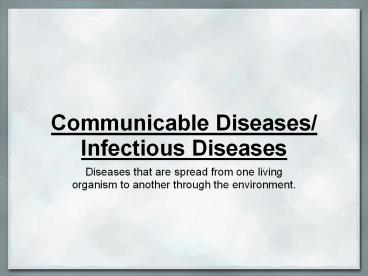Communicable Diseases/ Infectious Diseases - PowerPoint PPT Presentation
1 / 9
Title:
Communicable Diseases/ Infectious Diseases
Description:
Communicable Diseases/ Infectious Diseases Diseases that are spread from one living organism to another through the environment. What causes infectious diseases? – PowerPoint PPT presentation
Number of Views:666
Avg rating:3.0/5.0
Title: Communicable Diseases/ Infectious Diseases
1
Communicable Diseases/ Infectious Diseases
- Diseases that are spread from one living organism
to another through the environment.
2
What causes infectious diseases?
- Microscopic organisms, pathogens, invade the body
and attack its cells and tissues. When the
pathogens multiply and damage body cells it is
called having an infection. Most pathogens are
considered parasites, organisms that live in or
on another organism and derive nourishment from
it. - Examples of pathogens are
- bacteria
- viruses
- rickettsias
- protozoans
- fungi
3
Viruses
- Viruses are the smallest pathogens, they are a
ball of genes wrapped in a protein coat. - Viruses must have a host to survive, grow, and
reproduce. - Once inside the body viruses spread but infecting
cells.
4
Bacteria
- Bacteria is found everywhere on Earth.
- Bacteria are single celled organisms.
- Some bacteria is harmful but most are harmless or
helpful. - Disease causing bacteria can produce toxins,
which kill cells or interfere with cell
functions.
5
Protozoans, Fungi, and Rickettsias
- Protozoans
- Single-celled organisms that are larger than
bacteria and have a more complex cell structure.
Mostly harmless but some can cause disease in
humans. - Fungi
- Multi-celled plant-like organisms. They thrive
in damp, warm environments. Most commonly invade
hair, nails, and skin and cause infections - Rickettsias
- Look like small bacteria but like viruses must
invade a cell. Passed on through bites and feces
deposited on the skin.
6
How are Pathogens Spread?
- Pathogens are spread to people in various ways...
7
What do Pathogens do to the Body?
- Immunity, the body's natural defense against
infections, is what helps protect us from being
sick. - The immune system is a network of cells, tissues,
organs, and chemicals that help fight off
pathogens. - The body does many things to prevent pathogens
from getting into the body. - Physical Barriers skin, mucous membranes, tiny
hairs. Prevents pathogens from entering the
body. - Chemical Barriers Enzymes in tears and saliva
that can destroy bacteria. - Body Cells White blood cells called
Phagocytes. Phagocytes travel through the blood
and group together to destroy the pathogens. - Inflammatory Response Occurs when tissue damage
occurs. The blood vessels open up and allow more
phagocytes to the infected area. Antigens are
substances that can trigger an immune response. - When these first efforts don't work, the specific
resistance goes into effect.
8
Specific Resistance
- Lymphocytes, a special type of white blood cell
that fights pathogens. They flow through two
networks of vessels. - Blood Vessels
- Lymph Vessels
- There are two major types of Lymphocytes.
- B Cells turn into plasma cells that produce
antibodies. Antibodies are proteins that destroy
or neutralize invading particular pathogens. - T Cells two major types, killer and helper
cells. Attach to abnormal body cells and destroy
them. - Together these cells help control the Immune
System.
9
Preventing Infectious Diseases
- Immunity The body's natural resistance to many
pathogens - Active Immunity immunity your body develops to
protect you from disease. - Passive Immunity temporary immunity that an
infant acquires from its mother. - Immunization
- Passive Immunization immediate, short-lived
protection against specific disease causing
pathogens. - Active Immunization aka vaccination. The
introduction of the pathogen into the body. A
vaccine contains a preparation of dead or
weakened pathogens that are introduced to the
body to stimulate an immune response.































